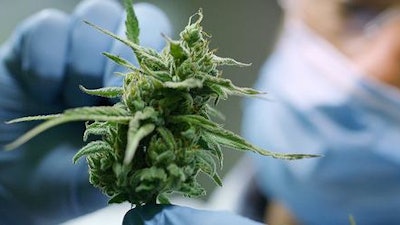
The widespread use of cannabis (marijuana) and its increased potency are associated with a rise in cannabis-related psychiatric conditions, according to a new University of Maryland School of Medicine (UMSOM) review article that was recently published in the New England Journal of Medicine. It highlights the urgent need for doctors to screen for and treat patients who are experiencing symptoms of cannabis use disorder, which means they are experiencing significant problems from their use of the drug.
Nearly one in five Americans ages 12 and older used cannabis in 2021, according to the article, and more than 16 million met the criteria for cannabis use disorder as outlined in the American Psychiatric Association’s Diagnostic and Statistical Manual of Health Disorders (DSM-5-TR). Young adults ages 18 to 25 are disproportionately affected. The review found more than 14 percent of those in this age group had cannabis use disorder.
“There is a lot of misinformation in the public sphere about cannabis and its effects on psychological health with many assuming that this drug is safe to use with no side effects,” said David A. Gorelick, MD, PhD, Professor of Psychiatry at UMSOM who wrote the review article. “It is important for physicians and the public to understand that cannabis can have addictive effects and to recognize signs and symptoms in order to get properly diagnosed and treated.”
Cannabis use disorder is defined as problematic marijuana use. Symptoms include craving the drug and failing to control its use despite experiencing negative side effects like problems at work or school. It is most prevalent in people who use cannabis more than four days a week. While the primary risk factors are the frequency and duration of cannabis use, having another substance use disorder or other psychiatric condition also increases the likelihood of the diagnosis.
“Almost 50 percent of people with cannabis use disorder have another psychiatric condition such as major depression, post-traumatic stress disorder, or generalized anxiety disorder,” said Dr. Gorelick. “It’s vital that patients seek the right psychiatric treatment to address their risk factors.”
Physical signs and symptoms of cannabis use disorder can range from yellowing of the fingertips to increased depression and anxiety while using cannabis. To be properly diagnosed by a clinician, however, patients must meet two or more criteria for cannabis use disorder as outlined by the DSM-5-TR. These include doing poorly at school or work or missing important family obligations due to cannabis use. Experiencing withdrawal symptoms or cravings for cannabis are other symptoms.
Dr. Gorelick, who is also Editor-in-Chief of the Journal of Cannabis Research, conducted the extensive review to educate physicians on the array of health issues that may be associated with short-term and long-term cannabis use as a growing number of individuals use cannabis products. He also aimed to heighten public awareness around cannabis user disorder, both in terms of recognizing its symptoms and understanding treatment options.
The paper also highlighted other dangers of excessive cannabis use: Cannabis use accounts for 10 percent of all drug-related emergency room visits in the U.S. and is associated with a 30 to 40 percent increased risk of car accidents. In 2022, 18 to 25-year-olds accounted for the highest rate of cannabis-related emergency department visits.
“Approximately one in ten people who use cannabis will become addicted, and for those who start before age 18, the rate rises to one in six,” said Mark T. Gladwin, MD, the John Z. and Akiko K. Bowers Distinguished Professor and Dean, UMSOM, and Vice President for Medical Affairs, University of Maryland, Baltimore. “As use of this drug increases, we must delve deeply into basic research to understand the brain’s cannabinoid system. We must also design translational studies of therapies that target these brain mechanisms to help those with cannabis use disorder -- particularly young adults and pregnant women -- overcome their dependence on this drug.”
A key part of UMSOM’s mission is to drive innovation in the field of addiction medicine, and to learn more about neurological differences in the brain that make some people more susceptible to drug abuse and addiction. As part of this mission, the school recently opened the Kahlert Institute for Addiction Medicine, which brings together leading addiction experts to collaborate on studying the brain mechanisms underlying addiction and to train a new generation of medical practitioners in the field of addiction medicine.
“There is still a lot we don’t understand about these conditions, including why some people experience cannabis-related disorders,” said Kahlert Institute Associate Director Asaf Keller, PhD, the Donald E. Wilson, MD, MACP Distinguished Professor and Chair of Neurobiology at UMSOM. “That is what we are trying to better understand through pre-clinical research studies. We are also working on developing treatments for cannabis -related disorders.”
There are currently seven recognized disorders related to cannabis use. Some include: cannabis-induced anxiety disorder, cannabis-induced psychotic disorder, cannabis-induced sleep disorder and cannabis-induced delirium, which manifests as hyperactivity, agitation and disorientation with hallucinations. Often, their symptoms can closely resemble those of their non-cannabis-related counterpart disorders.
To properly diagnosis patients for cannabis use disorder, the U.S. Preventive Services Task Force recommends that adolescents and adults be screened for cannabis use disorder (and other substance use disorders) in primary care settings as long as services for accurate diagnosis, treatment and appropriate care can be offered or referred. Screening is best done with a standalone or within a larger health questionnaire during a healthcare visit. While the FDA has not approved any medication as effective for the treatment of cannabis use disorder, certain therapies can help those with cannabis use disorder manage symptoms and reduce or stop their cannabis use. These include: Cognitive Interactive Therapy (CBT) and Motivational Enhancement Therapy (MET), which help patients to manage thoughts and behaviors that trigger their use of cannabis and to better understand why they use cannabis. Adolescents may gain additional benefits from family-based treatment options.
Therapy is becoming more widely available through telehealth services, but the stigma around mental illness and addiction and the shortage of mental healthcare professionals still create barriers to treatment for many patients, Gorelick said.






















